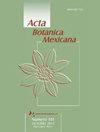Inclusions of flowers of Podopterus (Polygonaceae) in the Miocene amber of Simojovel de Allende, Chiapas, Mexico
IF 0.8
4区 生物学
Q4 PLANT SCIENCES
引用次数: 0
Abstract
Background and Aims: The Miocene amber from Chiapas, Mexico, shows high diversity of biological inclusions such as plants, fungi, arthropods, and vertebrates, being one of the most important amber-bearing areas worldwide. The aim of this work is to describe a new record based on four bisexual flowers belonging to the fossil species Podopterus mijangosae, that has been described recently based on its winged fruits only.Methods: The morphological and anatomical characteristics of the four fossil flowers were observed using a binocular stereoscopic microscope. The taxonomic affinity was decided by consulting specialized literature, as well as the review of herbarium material of the genera Podopterus, Fallopia, and Neomillspaughia of Polygonaceae.Key results: The four fossil specimens are bisexual, small, and have actinomorphic flowers, with differentiated perianth, three petals and three sepals per series, stamens are free and with thread-like filaments, anthers are dithecal and basifixed, the ovary is superior, syncarpous, 3-angular, with three free styles, and capitate stigmas. Conclusions: This new report of flowers of Podopterus adds more evidence that the family Polygonaceae was an important component of the tropical forest of Simojovel de Allende, Chiapas, Mexico, during the Miocene.墨西哥恰帕斯州Simojovel de Allende中新世琥珀中足足龙(蓼科)花的包裹体
背景与目的:墨西哥恰帕斯的中新世琥珀显示出植物、真菌、节肢动物和脊椎动物等生物包裹体的多样性,是世界上最重要的琥珀含藏区之一。这项工作的目的是根据属于化石物种Podopterus mijangosae的四种两性花的新记录进行描述,这些花最近仅根据其有翼的果实进行描述。方法:用双目立体显微镜观察4种花化石的形态解剖特征。通过查阅相关文献,以及对蓼科足蕨属(Podopterus)、Fallopia属(Fallopia)和新密藻属(Neomillspaughia)的标本馆资料的查阅,确定了其分类亲缘关系。关键结果:4个化石标本雌雄同体,体积小,花辐射形,花被分化,每系列3瓣3萼片,雄蕊离生,具线状花丝,花药双生,基生,子房上位,合心,3角,三游离花柱,头状柱头。结论:这一新报告为蓼科植物是墨西哥恰帕斯州Simojovel de Allende热带森林中新世的重要组成部分提供了更多证据。
本文章由计算机程序翻译,如有差异,请以英文原文为准。
求助全文
约1分钟内获得全文
求助全文
来源期刊

Acta Botanica Mexicana
生物-植物科学
CiteScore
1.60
自引率
12.50%
发文量
52
审稿时长
>12 weeks
期刊介绍:
Acta Botanica Mexicana da a conocer trabajos originales e inéditos en todas las áreas de la botánica, incluyendo florística, taxonomía, taxones nuevos para la ciencia, ecología, etnobotánica, paleontología, evolución, conservación, etc. Está dirigida a botánicos mexicanos y extranjeros que aporten información en estas áreas del conocimiento, particularmente con plantas nativas del continente americano. Hasta 2018 apareció cuatro veces al año con una periodicidad estricta en la primera semana de enero, abril, julio y octubre; a partir de 2019 se publica de manera continua, sin periodicidad preestablecida, en formato electrónico y de forma gratuita.
 求助内容:
求助内容: 应助结果提醒方式:
应助结果提醒方式:


